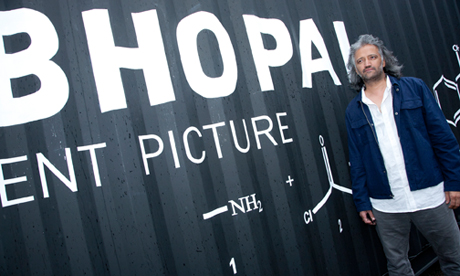Bhopal: A Silent Picture – review

Artist Samar Jodha at the launch of Bhopal: A Silent Picture. Photograph: Keith van-Loen
Dow Chemical Company has not had the best of years. Despite spending $63m on a ten-year partnership deal with the International Olympic Committee and shelling out a further $7m to sponsor the plastic wrap that now surrounds the Olympic stadium, the US-based company has not been able to shake the rancorous odour that is slowly swallowing its reputation.
Not even the prestige of sponsoring the Olympic Games has cleared the air. In fact the effect has been quite the opposite. For now more than ever, as the London Olympics opens, does Dow find its controversial history under the international spotlight.
For those unaware of Dow’s less than stellar reputation, Dow has been at the center of a fierce storm ever since its 2001 acquisition of Union Carbide Corporation (UCC), owners of the Bhopal pesticide plant in India at the time of the Bhopal gas tragedy (December, 1984), an incident that left thousands dead and many more inured. The issue of responsibility and compensation is still unresolved to this very day.
The Indian artist Samar Singh Jodha’s exhibition, Bhopal: A Silent Picture, hosted by long-time critic of Dow, Amnesty International, and now showing at the Human Rights Action Centre in Shoreditch, is another moving chapter in the Bhopal tragedy story.
Open to the public until July 31, Bhopal: A Silent Picture arrives in London just one week after the London Assembly passed a motion emphatically criticising the Olympic-Dow partnership and is yet another unwelcome development for the much-maligned chemical company.
The exhibition attempts to simulate the atmosphere of that fateful night in December 1984 and utilises temperature-control, 3-D images, mannequins, and a subtle and at times discomforting soundtrack that recreates the slow yet deadly spread of the leaking gas.
Although small, Bhopal: A Silent Picture does pack a considerable punch. In his own words Jodha wants those who enter to contemplate “moral obligation . . . to recognise that obligations to humanity extend far beyond those that can be imposed within the jurisdiction of any Court.”
However, although Bhopal: A Silent Picture does ask the audience “to reflect on wider issues about our unjust world”, its primary value lies in its ability to reconstruct the human narrative that should be at the centre of this compelling and tragic saga but is in reality often lost amongst the talk of corporate reputation, expensive lawsuits, and of course the question of ethical standards in the Olympic Games. As such, it is the most uncomplicated feature of this exhibition, a list of the names of the immediate victims, that provides the most lasting impact.
Bhopal: A Silent Picture has so far visited three cities and has been seen by over one hundred thousand people and its arrival in London is both welcome and needed. Yet if it were not for the Olympic circus that now dominates London life it is likely that the Dow-Bhopal saga would have remained largely unknown to the British public.
Let us hope, then, that once the Olympic spotlight fades the residents of Bhopal are not left in the dark. Hopefully Bhopal: A Silent Picture goes some way to ensuring that such a fate does not befall the already isolated Bhopali community.
Bhopal: A Silent Picture
Until Tuesday 31 July 2012
Human Rights Action Centre
17 – 25 New Inn Yard
Shoreditch
EC2A 3EA
